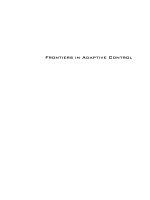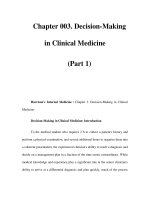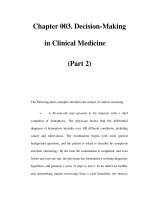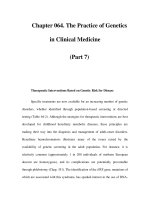Neurology Seminars in Clinical Neurology - part 1 pdf
Bạn đang xem bản rút gọn của tài liệu. Xem và tải ngay bản đầy đủ của tài liệu tại đây (653.81 KB, 11 trang )
www.dbeBooks.com - An Ebook Library
World Federation of Neurology
Seminars in Clinical Neurology
DYSTONIA
This Page Intentionally Left Blank
World Federation of Neurology
Seminars in Clinical Neurology
Dystonia
FACULTY
Joseph Jankovic, M.D., CHAIR
Professor of Neurology
Director of Parkinson’s Disease Center and Movement Disorders Clinic
Department of Neurology, Baylor College of Medicine
Houston, Texas
Series Editor
Theodore L. Munsat, MD
Pr
ofessor of Neurology Emeritus
Tufts University School of Medicine
Boston, Massachusetts
New Y
ork
Cynthia A. Comella, MD
Chair, Department of Neurology,
Beth Israel Medical Center
Professor, Department of Neurology,
Albert Einstien College of Medicine
New York, New York
Susan B. Bressman, MD
Neurological Institute,
Columbia Presbyterian Medical Center
New York, New York
Michele Tagliati, MD
Associate Professor
Division Chief, Movement Disorders
Mount Sinai School of Medicine
New York, New York
Michael Pourfar, MD
Division of Movement Disorders
Fellow, Department of Neurology
Columbia University Medical Center
New York, New York
Joseph K.C. Tsui, MBBS, MRCP, F.R CP(C)
Department of Neurology,
University of British Columbia
V
ancouver, British Columbia, Canada
Mark A. Stacy, MD
Medical Director, Division of Neurology,
Duke University
Durham, North Carolina
M. Fiorella Contarino, MD
Istituto di Neuroligia,
Universit Cattolica
Roma, Italy
Alberto Albanese, MD
Istituto Nazionale Neurologica Carol Besta
Milano, Italy
Daniel Truong, MD
The Parkinson’s and Movement
Disorders Institute
Fountain Valley, California
Mayank Pathak, MD
The Parkinson’s and Movement
Disorders Institute
Fountain V
alley, California
Karen Frei, MD
The Parkinson’s and Movement
Disorders Institute
Fountain Valley, California
Demos Medical Publishing, LLC.
386 Park Avenue South
New York, NY 10016, USA
V
isit our website at www.demosmedpub.com
© 2005 by World Federation of Neurology. All rights reserved.
This work protected under copyright under the World Federation of Neurology and the following
terms and conditions apply to its use:
Photocopying
Single photocopies of single chapter, may be made for personal use as allowed by national copy-
right laws. Multiple or systematic copying is permitted free of charge for educational institutions that
wish to make photocopies for non-profit educational classroom use, but not for resale or commer-
cial purposes.
Per
mission of the World Federation of Neurology is required for advertising or promotional purpos-
es, resale and all forms of document delivery.
Permissions may be sought directly from the World Federation of Neurology, 12 Chandos Street,
London W1G 9DR, UK.
Derivative Works
Tables of Contents may be reproduced for internal circulation but permission of the World
Federation of Neurology is required for resale of such material.
Permission of the World Federation of Neurology is required for all other derivative works, includ-
ing compilations and translations.
Notice
No responsibility is assumed by the World Federation of Neurology for any injury and/or damage to
persons or property as a matter of products liability, negligence or otherwise, or from any use of
operation of any methods, products, instructions, or ideas contained in the material herein. Because
of the rapid advances in the medical sciences, in particular, independent verification of diagnoses
and drugs dosages should be made.
First edition 2005
Library of Congress Cataloging-in-Publication Data
Dystonia / [edited by] Joseph Jankovic.
p. ; cm.
Includes bibliographical references and index.
ISBN 1-888799-87-0 (pbk. : alk. paper)
1. Dystonia.
[DNLM: 1. Dystonia. 2. Dystonic Disorders. ] I. Jankovic, Joseph.
RC935.D8D97 2005
616.7'4—dc22
2004031069
v
Dystonia is a neurologic disorder characterized by involuntary, sustained, patterned, and often repetitive muscle
contractions of opposing muscles that cause twisting movements, abnormal postures, or both (1). One of the ear-
liest descriptions of dystonia was provided in 1888 by Gowers, who used the term “tetanoid chorea” to describe
the movement disorder in two siblings who were later diagnosed to have Wilson’s disease. The term “dystonia
musculorum defor
mans,” coined by Oppenheim in 1911, was criticized for several reasons: fluctuating muscle tone
was not necessarily characteristic of the disorder; the term “musculorum” incorrectly implied that the involuntary
movement was due to a muscle disorder; and not all patients became deformed. More recently, the term “torsion
dystonia” has been used in the literature, but since torsion is part of the definition of dystonia, this term seems
redundant. Hence, the simple term “dystonia” is currently preferred and used to describe the phenomenology of
this movement disorder. When used to describe a disease, it should be prefaced as either primary (without any
associated neurologic deficit; it may be idiopathic or genetic) or secondary (caused by a variety of etiologies such
as brain insult, certain drugs, and a variety of heredodegenerative disorders).
The primary objective of this seminar is to provide a practical review of dystonia that emphasizes cost-effective
evaluation and treatment. This should be of particular value to physicians in developing countries who have lim-
ited diagnostic and therapeutic resources. Maintaining this focus is challenging in view of the increasing depend-
ence on the latest imaging, genetic, and other technologies to evaluate patients with neurologic disorders.
Furthermore, there is growing emphasis on evidence-based medicine to select only treatments that have proved
efficacy and safety. However, these treatments may not be readily accessible in developing countries. For exam-
ple, until recently pallidotomy, rather than medication, was the preferred treatment for Parkinson’s disease in some
countries, as the cost of surgery was less than long-term treatment with levodopa or dopamine agonists. A more
relevant issue with respect to dystonia is the use of botulinum toxin, considered the treatment of choice for many
focal or segmental dystonias (2). While relatively costly, this treatment has such important beneficial impact on
the function, productivity, and quality of life of the affected individual, as demonstrated by many well-designed
studies, that it may be cost-ef
fective even in the setting of limited r
esour
ces.
The contributors to this seminar have addressed these issues and balanced the advantages of the latest tech-
nologies and treatments against the practicality of the “real-world” situation facing health care providers in devel-
oping countries as they evaluate patients with dystonia and r
elated movement disorders. I believe that the r
esult
is a collection of scholarly and, at the same time, practical reviews.
I am grateful to the authors for sharing their expertise and for providing excellent material. I also would like
to thank T
ed Munsat, MD for inviting me to chair this seminar and for having the confidence that the authors
I selected would meet the challenge. Finally, I would like to express my appreciation to Dr. Diana M. Schneider
for her constant encouragement and guidance.
Joseph Jankovic, MD
1. Jankovic J, Fahn S. Dystonic disorders. In: Jankovic J, Tolosa E, (eds.) Parkinson’s Disease and Movement Disorders. 4th ed. Philadelphia,
PA: Lippincott Williams & Wilkins. 2002:331–357.
2. Jankovic J. Botulinum toxin in clinical practice.
J Neurol Neurosurg Psychiatry. 2004;75:951-957.
Preface
The mission of the World Federation of Neurology (WFN, wfneurology.org) is to develop international programs
for the improvement of neurologic health, with an emphasis on developing countries. A major strategic aim is to
develop and promote affordable and effective continuing neurologic education for neurologists and related health
care providers. With this continuing education series, the WFN launches a new effort in this direction. The
WFN
Seminars in Neur
ology
uses an instructional for
mat that has proven to be successful in controlled trials of educa-
tional techniques. Modeled after the American Academy of Neurology’s highly successful Continuum, we use
proven pedagogical techniques to enhance the effectiveness of the course. These include case-oriented informa-
tion, key points, multiple choice questions, annotated references, and abundant use of graphic material.
In addition, the course content has a special goal and direction. We live in an economic environment in which
even the wealthiest nations have to restrict health care in one form or another. Especially hard pressed are coun-
tries where, of necessity, neurologic care is often reduced to the barest essentials or less. There is general agree-
ment that much of this problem is a result of increasing technology. With this in mind, we have asked the facul-
ty to present the instructional material and patient care guidelines with minimal use of expensive technology.
Technology of unproven usefulness has not been recommended. However, at the same time, advice on patient
care is given without compromising a goal of achieving the very best available care for the patient with neurolog-
ic disease. On occasion, details of certain investigative techniques are pulled out of the main text and presented
separately for those interested. This approach should be of particular benefit to health care systems that are
attempting to provide the best in neurologic care but with limited resources.
These courses are provided to participants by a distribution process unusual for continuing education materi-
al. The WFN membership consists of 86 individual national neurologic societies. Societies that have expressed an
interest in the program and agree to meet certain specific reporting requirements are provided a limited number
of courses without charge. Funding for the program is provided by unrestricted educational grants. Preference is
given to neurologic societies with limited resources. Each society receiving material agrees to convene a discus-
sion gr
oup of participants at a convenient location within a few months of r
eceiving the material. This discussion
group becomes an important component of the learning experience and has proved to be highly successful.
Our third course addresses the important area of management of the dystonias. The Chair of this course,
Pr
ofessor Joseph Jankovic, a r
ecognized international authority, has selected an outstanding faculty of experts. We
very much welcome your comments and advice for future courses.
Theodor
e L. Munsat, M.D.
Professor of Neurology Emeritus
Tufts University School of Medicine
Boston, Massachusetts
Editor’s Preface
vi
vii
The World Federation of Neurology and faculty of this course on Dystonia gratefully acknowledge the assistance
provided for its development by Allergan, and especially the assistance of Dr. G.K. Kannan.
Acknowledgment
Preface . . . . . . . . . . . . . . . . . . . . . . . . . . . . . . . . . . . . . . . . . . . . . . . . . . . . . . . . . . . . . . . . . . . .v
Editor’s Preface . . . . . . . . . . . . . . . . . . . . . . . . . . . . . . . . . . . . . . . . . . . . . . . . . . . . . . . . . . . . .vi
Acknowledgment . . . . . . . . . . . . . . . . . . . . . . . . . . . . . . . . . . . . . . . . . . . . . . . . . . . . . . . . . . .vii
1.
Diagnosis, Classification, and Pathophysiology of Dystonia
Cynthia A. Comella, MD
. . . . . . . . . . . . . . . . . . . . . . . . . . . . . . . . . . . . . . . . . . . . . . . . . . . . . . .1
2. The Genetics of Dystonia
M. Tagliati, MD, M. Pourfar, MD, and Susan B. Bressman, MD . . . . . . . . . . . . . . . . . . . . . . . . . . .9
3. Craniocervical Dystonia
Joseph K.C. Tsui, MBBS, MRCP FRCP(C) . . . . . . . . . . . . . . . . . . . . . . . . . . . . . . . . . . . . . . . . . .17
4. Limb and Generalized Dystonia
Mark A. Stacy, MD . . . . . . . . . . . . . . . . . . . . . . . . . . . . . . . . . . . . . . . . . . . . . . . . . . . . . . . . . .23
5. Medical and Surgical Treatment of Dystonia
M. Fior
ella Contarino, MD and Alberto Albanese, MD
. . . . . . . . . . . . . . . . . . . . . . . . . . . . . . . .
31
6.
Rehabilitation Exercises
Daniel Truong, MD, Mayank Pathak, MD, and Karen Frei, MD . . . . . . . . . . . . . . . . . . . . . . . . . .43
Index . . . . . . . . . . . . . . . . . . . . . . . . . . . . . . . . . . . . . . . . . . . . . . . . . . . . . . . . . . . . . . . . . . . .53
Contents
viii
1
C
HAPTER 1
DIAGNOSIS, CLASSIFICATION, AND
PATHOPHYSIOLOGY OF DYSTONIA
Cynthia A. Comella, MD
CASE 1
A 10-year-old boy presented with a history of progres-
sive abnormal movements beginning 2 years previously.
The first symptom observed by his parents was a limp,
and inversion of the right foot that occurred when the
child ran. The posture disappeared when the child
walked or stood still. The movements were continuous
during the day but ceased during sleep.
This patient was active in sports, and a member of the
soccer and track teams. Initially, it was suspected that his
symptoms were the result of a strain injury. However,
splinting and r
est did not improve his condition. The
symptoms progressed, and the foot posturing began to
occur when walking. Over the next year, posturing was
noted in the entire leg and torso, with bending of the
trunk to the right. During this time, his parents were
having financial difficulties that caused an unstable
home situation. The child's symptoms were attributed to
a reaction to his stressful home environment, and he was
referred to a psychiatrist for evaluation and treatment
of a psychogenic disorder. Despite intensive psychother-
apy
, involvement of the other foot and leg occur
red,
resulting in an inability to walk, and the patient became
wheelchair bound. Spasms affected his limbs, trunk, and
neck. The child was referred to a neurologist. At the time
of his examination, the boy demonstrated severe spasms
with abnormal posturing of his limbs and spasms in
which his trunk would arch and his head would be
thrown backward. The remainder of his neurologic and
physical examination was normal. His deep tendon
reflexes were normal. Cognitive functioning and psycho-
logic testing were also normal. There was no family his-
tory of any neurologic problem.
Dystonia is defined as a clinical syndrome with invol-
untary sustained muscle contractions that usually pr
o-
duce twisting and repetitive movements or abnormal
postures. Symptoms particular to this syndrome help
distinguish it fr
om other movement disorders. For
example, there may be overlying spasms that can
appear tremorlike; in this case, the directional quality
of the movement distinguishes dystonia fr
om the
tremor disorders. The movements of dystonia also tend
to be slower than the rapid muscle jerks present in tic
disorders. In addition, the occurrence in the foot as the
initial presentation is unusual for a tic disorder, which
fr
equently presents with eye blinks or facial jerks.
Finally, dystonia characteristically exhibits a patterned
movement with consistent posturing, unlike chorea,
which produces rapid, unpredictable movement.
The diagnosis of dystonia is based entirely on the
clinical examination. Currently, there is no supporting
laboratory or imaging tests to confirm the diagnosis.
Dystonia is traditionally classified by 1 of 3 means: dis-
tribution (body areas involved), age of onset, and etiol-
ogy (Tables 1.1–1.3).
DIAGNOSIS OF DYSTONIA
The onset of dystonia in this young patient would ini
-
tially have been classified as a focal dystonia with iso-
lated involvement of the right foot. At onset, the
dystonia was action dependent, with foot inversion
occurring only when the child ran; it later progressed
to presence at rest. This dystonia spread to become
generalized dystonia with involvement of both legs,
the torso, and the neck. This type of spread is common
in childhood-onset dystonia.
The dystonia in this patient would have been fur-
ther classified as a primary dystonia because there
were no additional neurologic or cognitive deficits to
Dystonia is a clinical syndrome marked by sustained
abnormal postures. It may be misdiagnosed as a
psychogenic disorder by a clinician unfamiliar with its
clinical features.
Childhood-onset dystonia often begins in the leg and
generalizes to other body regions; adult-onset dystonia
usually begins in the neck or face and rar
ely generalizes
to other body r
egions.
suggest a secondary dystonia. In the absence of these
or other medical problems, no additional laboratory
testing is necessary. Although DYT1 testing is com-
mercially available, at this time, it does not alter treat-
ment appr
oaches and may be delayed until
therapeutic modalities ar
e specifically aimed at the
DYT1 gene.
If additional findings wer
e pr
esent—such as spastic
-
ity, delayed developmental milestones, loss of mile-
stones, cognitive impair
ment, or featur
es of
parkinsonism—the dystonia would then be consider
ed
a secondary dystonia and additional assessments for an
underlying neur
ologic or metabolic disease might be
indicated. These would include brain imaging, labora
-
tory testing, and appropriate metabolic testing for pedi-
atric disorders. A history of diurnal variation of the dys-
tonia, with symptoms worsening over the course of the
day and improvement following sleep, would suggest
dopa-responsive dystonia (DRD), a disorder that is
important to recognize because small doses of lev-
odopa may provide dramatic sustained improvement.
These children may have signs of parkinsonism and
spasticity and be misdiagnosed as having cerebral
palsy. Because levodopa may reverse most symptoms
over a prolonged period of treatment, children with
generalized dystonia should be given a trial of lev-
odopa up to 600 mg per day in divided doses.
This patient was initially diagnosed as having a psy-
chogenic dystonia. The occurrence of dystonia with
particular actions, such as running, and the r
eduction
of dystonic symptoms during sleep, may lead to a mis-
diagnosis of psychogenic movement disorder and sub-
sequent attempts to identify psychologic factors that
underlie symptoms. Psychotherapy is ineffective in
reducing dystonia symptoms. The hallmarks of psy-
chogenic dystonia include bizarr
e, inconsistent move-
ments that are often distractible. An example of a
psychogenic movement disorder would be a posturing
of the fingers that varies in its appearance and disap-
pears when complex finger tapping is performed by
the other hand.
The diagnosis of drug-induced dystonia requires a
history of exposure to particular medications that can
cause dystonic reactions. Particularly in children, dyston-
ic reactions may result from the use of certain antiemet-
DYSTONIA
2
Primar
y dystonia is dystonia that occurs without an
identifiable etiology. Patients with primary dystonia
infrequently require extensive laboratory or
neur
oimaging studies.
C
lassification of Dystonia by Distribution
TABLE 1.1
Classification Areas of involvement Examples
Focal A single body area Eye closure (blepharospasm), neck
muscles (cervical dystonia), writer's cramp
(Limb dystonia), vocal cords (spasmodic
dysphonia
S
egmental Two contiguous body regions Blepharospasm and lower face or jaw
(Meige syndrome)
Cervical dystonia and
writer's cramp
Generalized One leg, trunk, and one
other body region
OR
Both legs and trunk Childhood onset with spread
Multifocal Two noncontiguous body regions Blepharospasm and foot dystonia
Hemidystonia Body regions on one side Arm and leg on one side of the body
Classification of Dystonia by Age of
Onset
TABLE 1.2
Classification Age
Childhood onset Onset of symptoms at age <21
Adult Onset Onset of symptoms at age >21









